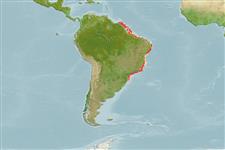Common names from other countries
Teleostei (teleosts) >
Pleuronectiformes (Flatfishes) >
Achiridae (American soles)
Etymology: Trinectes: Greek, tres, tria, = three + Greek, nekton = swimmer (Ref. 45335).
Environment: milieu / climate zone / depth range / distribution range
Ecology
Marine; freshwater; brackish; demersal; depth range 1 - 16 m (Ref. 36453). Tropical; 7°N - 29°S, 55°W - 30°W
Western Atlantic: Suriname to Brazil.
Size / Weight / Age
Maturity: Lm ? range ? - ? cm
Max length : 20.5 cm TL male/unsexed; (Ref. 102462); common length : 12.0 cm TL male/unsexed; (Ref. 5217); max. published weight: 177.96 g (Ref. 102462)
Found more abundantly on shallow soft bottoms of brackish estuaries or hypersaline lagoons. Enters freshwaters at least to an elevation of 10 m. Inhabits rivers and creeks and probably feeds on aquatic insects and crustaceans (Ref. 36880).
Life cycle and mating behavior
Maturities | Reproduction | Spawnings | Egg(s) | Fecundities | Larvae
Cervigón, F., R. Cipriani, W. Fischer, L. Garibaldi, M. Hendrickx, A.J. Lemus, R. Márquez, J.M. Poutiers, G. Robaina and B. Rodriguez, 1992. Fichas FAO de identificación de especies para los fines de la pesca. Guía de campo de las especies comerciales marinas y de aquas salobres de la costa septentrional de Sur América. FAO, Rome. 513 p. Preparado con el financiamento de la Comisión de Comunidades Europeas y de NORAD. (Ref. 5217)
IUCN Red List Status (Ref. 130435)
CITES (Ref. 128078)
Not Evaluated
Threat to humans
Harmless
Human uses
Tools
Special reports
Download XML
Internet sources
Estimates based on models
Preferred temperature (Ref.
115969): 22.6 - 28.1, mean 27.5 (based on 223 cells).
Phylogenetic diversity index (Ref.
82804): PD
50 = 0.5010 [Uniqueness, from 0.5 = low to 2.0 = high].
Bayesian length-weight: a=0.01148 (0.00909 - 0.01450), b=3.13 (3.06 - 3.20), in cm Total Length, based on LWR estimates for this species (Ref.
93245).
Trophic level (Ref.
69278): 3.3 ±0.45 se; based on food items.
Resilience (Ref.
120179): High, minimum population doubling time less than 15 months (Preliminary K or Fecundity.).
Fishing Vulnerability (Ref.
59153): Low vulnerability (11 of 100).
